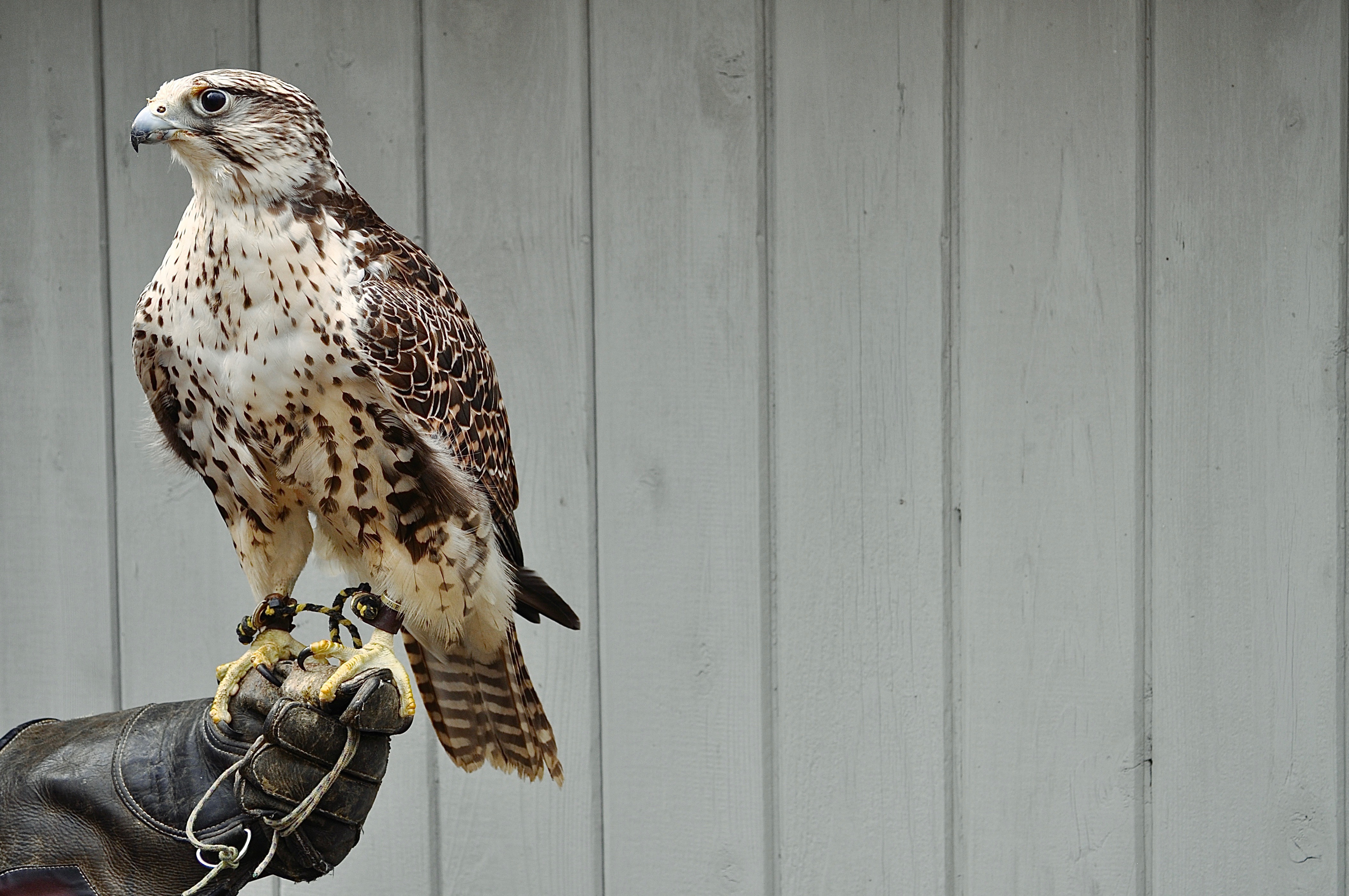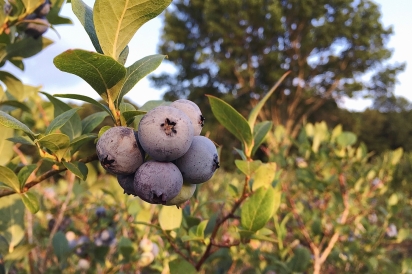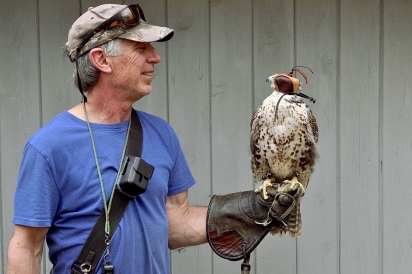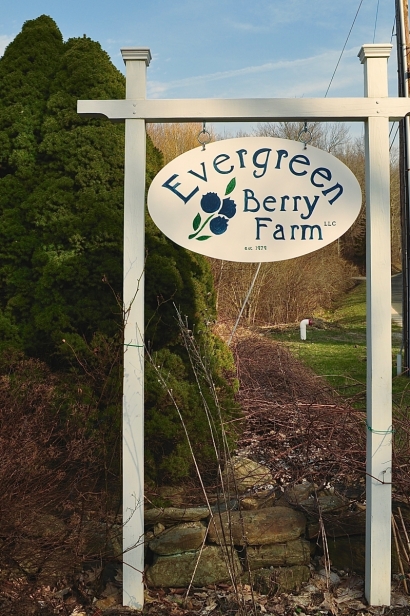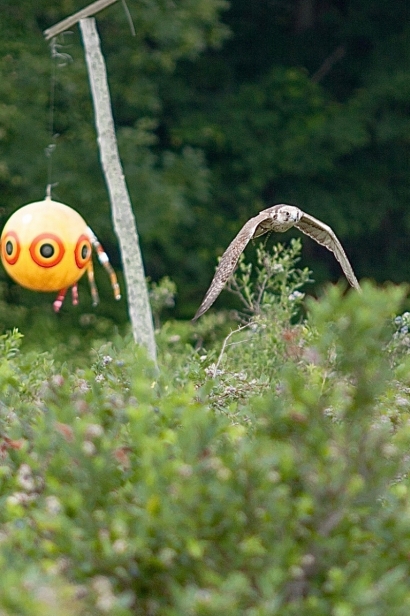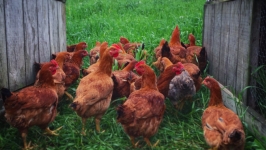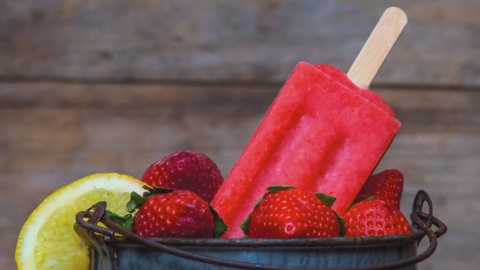The Sentinel
Visitors making their way up the winding gravel driveway of Evergreen Berry Farm in Watertown are greeted by a pastoral setting. On the left are billowing black raspberry canes, laden with fruit; to the right, an irrigation pond being surveyed by a great blue heron. But more often than not, the center of attention for visiting families is the statuesque gyr-saker falcon, Zoe, who can be found perched on the gloved hand of farm owner and falconer, Bob Alex.
Bob and his wife, Cathee Alex, opened their 27-acre farm in 1979, on which they use sustainable farming practices to grow roughly a dozen varieties of blueberries alongside blackberries, black raspberries, and red raspberries. Visitors are welcomed to the farm during summer months to pick their own berries and enjoy a house-made drink from the farm stand, a small barn newly equipped with a commercial kitchen.
Managing six miles of blueberry rows organically and biodynamically is no small feat. That’s where Zoe comes in. The female gyr-saker is 30% larger than males of the species, weighing in at about 940 grams for her flying weight. Her job (beyond captivating an audience) is to keep the berry-eating and flocking birds out of the field. Blue jays, robins, and catbirds will eat the berries, while starlings and cedar waxwings tend to arrive in large numbers and, besides eating their share, are sometimes prone to pecking the berries, thus rendering them unmarketable. The farm is in a uniquely difficult position for biodynamic pest management, as it is surrounded by a natural shelterbelt that gives the birds optimal coverage in the forest. The songbirds delight in this ecotone, with a bountiful summer food supply in one biome and a sanctuary of dense woodlands in the other. As a result, Zoe has her work cut out for her.
The process of becoming a falconer is no simple undertaking, and Zoe’s role on the farm is the result of years of dedication to the art. Bob Alex received his falconry license in 2005, the same year it became legalized in Connecticut. At the time, there were no sponsors in the state under whom an aspiring falconer could apprentice. Alex said he called a falconer in New York five times, leaving five different messages before the sponsor returned his call, saying, “I guess you’re serious about this. Why don’t you come over and see me?”
“The sponsor was weeding out the impulsive,” says Alex with a chuckle. “Falconry is not a sport for everyone. You have to be very dedicated, you have to be willing to learn a lot, or it’s not going to work.”
Thus, Alex made his way to New York to meet with James Eyring, the Assistant Director of the Environmental Center at Pace University. A Master Falconer, Eyring was able to teach Alex falconry as a form of bird abatement. Eyring utilizes his raptors at Pace similarly, as a means of warding off birds from the campus’ grounds and sports fields. After apprenticing under Eyring, Alex took that shared experience and knowledge back to his farm. Over the past 13 years, the farmer has had six different birds of prey. His first was a juvenile red-tailed hawk that he trapped in New York. Since returning that hawk to the wild after two years of training and hunting with it, Alex has had two male gyr-saker falcons, a merlin, a gyr-peregrine, and his current raptor, Zoe, all of which were bred in captivity. When asked what raptors were most effective for his needs at the berry farm, Alex said that male gyr-sakers and the merlins were most adept at rooting out the smaller birds from the rows of bushes, as their smaller size affords them greater agility in the field.
Even though Zoe is not weeding out the fruit eating birds who make a home in the bushes, she does well at keeping the flocks out. “Just her presence on my fist is enough to keep the starlings and some cedar waxwing flocks out. If I pick her up and they see her pointed wings, they understand she is a falcon,” says Alex with a smile. “Birds’ instincts are unbelievable. It’s genetic. They don’t want to have anything above them, and they recognize if they should fear other birds just by their silhouettes, wing beats, and manner of flight.”
Falconry, however, is not a panacea for bird troubles on the farm. Zoe cannot keep all of the birds out of the field single handedly, and she is just one of the farm’s active forms of Integrated Pest Management (IPM). In an attempt to deter birds from entering their fields, the farm also utilizes scare-eye balloons (painted with representations of large eyes that mimic a predator’s gaze), bird machines that sound the calls of birds in distress, and even lasers. Relying on falconry as the only form of bird abatement on the farm would take more raptors and more work, says Alex. “Ideally, for me to take care of the bird problem here, I would need at least two raptors, maybe three. I would need to fly them all day long, and I would need to have different species of raptors to manage different songbird species, including a smaller falcon than I have now.”
It is also possible (and even likely in a woodland-bordered field like Evergreen’s) that the birds of prey can find themselves the ones being hunted. This was the case when a resident female red-tailed hawk attacked and killed a male gyr-saker falcon of Alex’s, five years ago. Red-tailed hawks are not the only assassin in this farm’s ecosystem, he explains. “Cooper’s [hawks] have attacked all of my falcons. They’re under the assumption that they can attack any falcon so long as they have some advantage, so they’ll come screaming out of the woods.” While it is not surprising that wild raptors pose a risk to Alex’s falcons, some unlikely species of birds can also be a nuisance. “I’ve seen hummingbirds take on my falcons. If a hummingbird wants a falcon out of their territory, they’ll take their beak and get at them right in the back.”
Even with a wealth of experience from over 30 years of farming and 10 years as a falconer, Bob Alex continues to be fascinated by the ecosystem of his farm and the instincts of his falcons. “The bird life is amazing when you start to watch it,” says Alex. “I’m really thankful that I got into falconry just to start to understand all of the different birds. I’m still learning.” At Evergreen Berry Farm, that commitment to learning is reflected in their dedication to sustainable and ecologically friendly land and pest management, which results in stronger soils, happier plants, and the best possible experience for their patrons. And for Zoe, plenty of job security.
Evergreen Berry Farm: 435 Bassett Rd., Watertown; 860-274-0825


